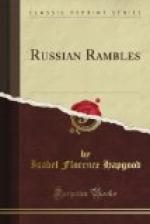The plain facades of the older buildings on this part of the Prospekt, which are but three or four stories in height,—elevators are rare luxuries in Petersburg, and few buildings exceed five stories,—are adorned, here and there, with gayly-colored pictorial representations of the wares for sale within. But little variety in architecture is furnished by the inconspicuous Armenian, and the uncharacteristic Dutch Reformed and Lutheran churches which break the severe line of this “Tolerance Street,” as it has been called. Most fascinating of all the shops are those of the furriers and goldsmiths, with their surprises and fresh lessons for foreigners; the treasures of Caucasian and Asian art in the Eastern bazaars; the “Colonial wares” establishments, with their delicious game cheeses, and odd studena (fishes in jelly), their pineapples at five and ten dollars, their tiny oysters from the Black Sea at twelve and a half cents apiece.
Enthralling as are the shop windows, the crowd on the sidewalk is more enthralling still. There are Kazaks, dragoons, cadets of the military schools, students, so varied, though their gay uniforms are hidden by their coats, that their heads resemble a bed of verbenas in the sun. There are officers of every sort: officers with rough gray overcoats and round lambskin caps; officers in large, flat, peaked caps, and smooth-surfaced voluminous cape-coats, wadded with eider-down and lined with gray silk, which trail on their spurs, and with collars of costly beaver or striped American raccoon, and long sleeves forever dangling unused. A snippet of orange and black ribbon worn in the buttonhole shows us that the wearer belongs to the much-coveted military Order of St. George. There are civilians in black cape-coats of the military pattern, topped off with cold, uncomfortable, but fashionable chimneypot hats, or, more sensibly, with high caps of beaver.
It is curious to observe how many opinions exist as to the weather. The officers leave their ears unprotected; a passing troop of soldiers— fine, large, hardy fellows—wear the strip of black woolen over their ears, but leave their bashlyks hanging unused on their backs, with tabs tacked neatly under shoulder-straps and belts, for use on the Balkans or some other really cold spot. Most of the ladies, on foot or in sledges, wear bashlyks or Orenburg shawls, over wadded fur caps, well pulled down to the brows. We may be sure that the pretty woman who trusts to her bonnet only has also neglected to put on the necessary warm galoshes, and that when she reaches home, sympathizing friends will rub her vain little ears, feet, and brow with spirits of wine, to rescue her from the results of her folly. Only officers and soldiers possess the secret of going about in simple leather boots, or protected merely by a pair of stiff, slapping leather galoshes, accommodated to the spurs.




